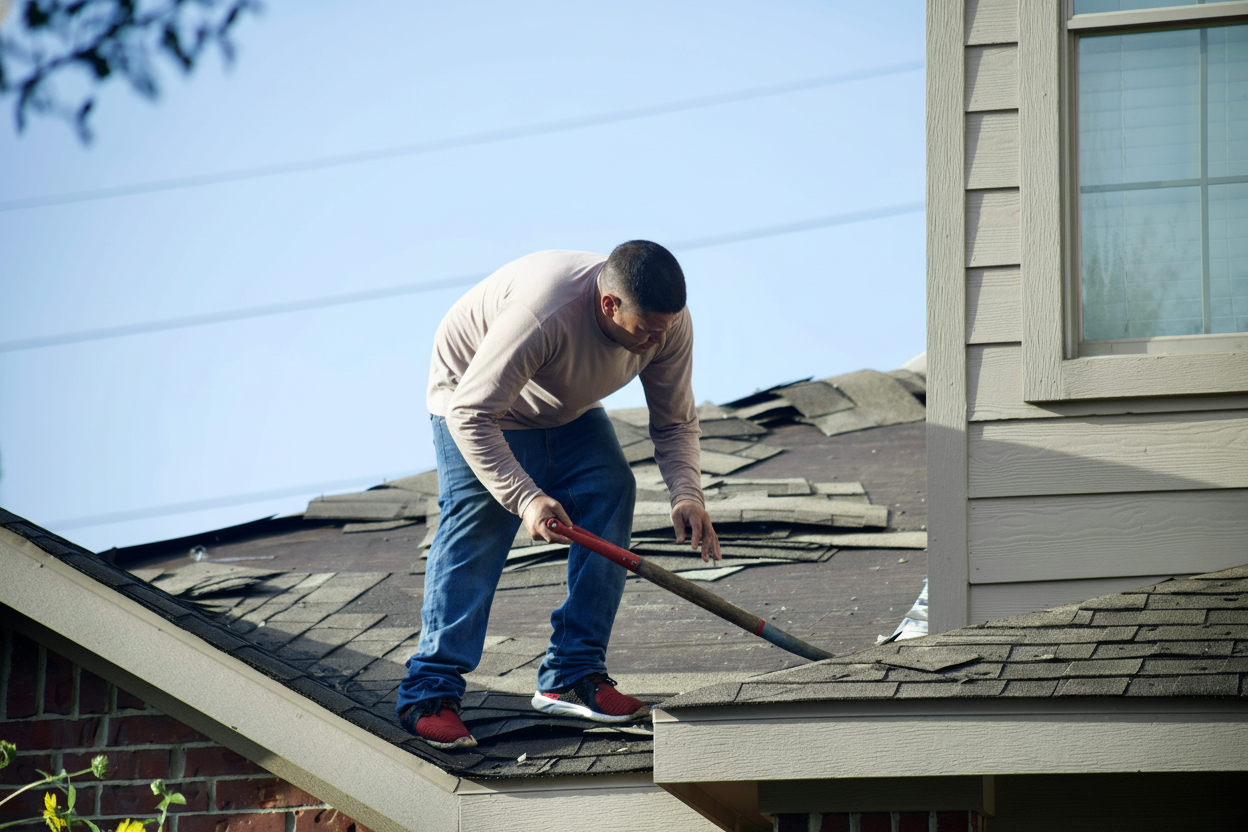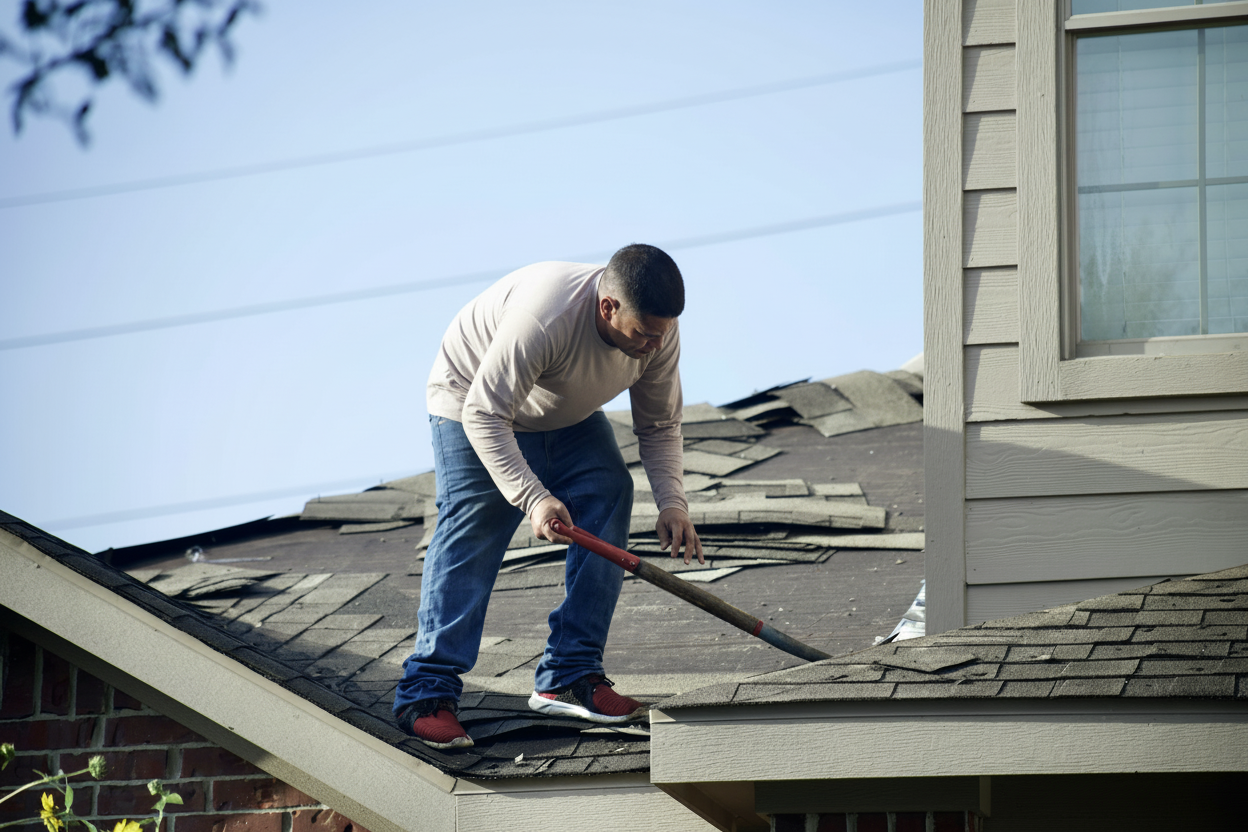How long does a roof last in 2025? Lifespan by material
Uncategorized
November 22,2025
How long does a roof last in 2025? Lifespan by material

Alt text: Homeowner examining different roofing materials on a residential property
Your roof stands between your family and the elements every single day. As a homeowner, understanding how long your roof will last helps you plan maintenance, budget for repairs, and know when replacement becomes necessary. Different roofing materials offer varying lifespans, and several factors influence how well your roof performs over time.
Quick insight: The average roof lasts 20 to 50 years depending on material, but proper maintenance can add 5 to 10 years to that lifespan.
This guide breaks down the expected lifespan of common roofing materials and shares practical tips to help you maximize your roof’s performance. Whether you’re planning a new installation or evaluating your current roof, you’ll find the information you need to make confident decisions.
What affects how long your roof lasts
Before looking at specific materials, you should understand the key factors that influence roof longevity. Your roof doesn’t exist in isolation. Multiple elements work together to determine how many years of protection you’ll get.
Climate and weather patterns play the largest role. Homes in areas with extreme temperature swings, heavy snow, or frequent storms typically see shorter roof lifespans. UV radiation from intense sunlight gradually breaks down roofing materials, while moisture from rain and humidity can cause rot or encourage algae growth.
Installation quality matters more than most homeowners realize. Even premium materials will fail early if not installed correctly. Proper ventilation, underlayment, and flashing installation all contribute to your roof’s ability to withstand decades of exposure. Working with experienced contractors ensures your roof gets the foundation it needs for a long life.
Maintenance reminder: Regular maintenance extends any roof’s lifespan significantly by addressing minor damage before it spreads and protecting your investment.
The pitch or slope of your roof also affects longevity. Steeper roofs shed water more effectively, reducing moisture exposure and wear. Flatter roofs may pool water, which accelerates deterioration if drainage isn’t properly managed.
Roofing material lifespans compared
Each roofing material brings different strengths, aesthetics, and longevity expectations. Here’s what you can expect from the most common options.
| Material | Average Lifespan | Best For |
|---|---|---|
| Asphalt Shingles | 15-30 years | Budget-conscious homeowners |
| Metal Roofing | 40-70 years | Long-term investment |
| Clay/Concrete Tiles | 40-75 years | Durability and fire resistance |
| Slate | 50-100+ years | Premium, lasting protection |
Asphalt shingles remain the most popular choice across residential properties. Their 15 to 30 year lifespan makes them affordable and practical. Architectural shingles typically outlast three-tab versions by 5 to 10 years. You’ll find these work well in most climates, though extreme heat or cold can shorten their life.
Metal roofing delivers impressive longevity at 40 to 70 years or more. Steel, aluminum, and copper options resist fire, wind, and pests effectively. Metal roofs require minimal maintenance beyond occasional inspections and cleaning. Their reflective properties can also reduce cooling costs in warm climates.
Wood shingles and shakes offer natural beauty with a 20 to 40 year lifespan when properly maintained. Cedar and redwood varieties resist insects and decay naturally. However, these require more attention than other materials. Regular cleaning, sealing, and prompt replacement of damaged pieces keeps wood roofs performing well.
Clay and concrete tiles provide 40 to 75 years of protection with excellent fire and pest resistance. Their weight requires proper structural support, but they handle extreme temperatures and weather exceptionally well. Inspect tiles regularly for cracks, as replacing damaged tiles prevents water infiltration.
Slate roofing represents the premium option with 50 to 100 years or more of service. This natural stone material resists virtually everything nature throws at it. While installation costs run high, the extremely long lifespan and minimal maintenance needs often justify the investment for homeowners planning to stay in their homes long-term.
Synthetic materials like composite shingles and synthetic slate offer 30 to 50 years of performance. These materials mimic the appearance of natural options while providing lighter weight and often lower costs. They require regular inspections to catch and address any damage early.

Alt text: Professional roofing contractor installing high-quality roofing materials on a modern home
How to extend your roof’s lifespan and when replacement makes sense
You can take specific steps to help any roof reach or exceed its expected lifespan. These practical maintenance approaches protect your investment and prevent costly early replacement.
Schedule regular inspections at least twice yearly, particularly after severe weather. Look for loose or missing shingles, damaged flashing, and signs of wear around chimneys and vents. Catching small issues early prevents them from becoming major problems.
Address repairs immediately when you spot damage. Water infiltration spreads quickly once it starts. What begins as a small leak can lead to structural damage, mold growth, and interior destruction. Quick action saves money and extends roof life.
Maintain proper attic ventilation to prevent heat and moisture buildup. Excess heat accelerates shingle deterioration from the inside out, while trapped moisture encourages rot and mold. Adequate ventilation helps your roof breathe and perform optimally.
Keep gutters clean and functional so water flows away from your roof properly. Clogged gutters cause water to pool on roof edges, leading to rot, leaks, and ice dams in winter. Regular cleaning prevents these issues.
Trim overhanging branches that could scrape your roof or drop debris. Fallen branches during storms can cause significant damage. Keeping trees properly trimmed reduces this risk and prevents leaf accumulation that traps moisture.
Remove moss and algae growth as soon as you notice it. These organisms hold moisture against roofing materials and can cause premature deterioration. A mixture of water and appropriate cleaning solution typically handles removal safely.
Consider protective coatings for eligible roof types. Reflective coatings can reduce UV damage and heat absorption, extending life while potentially lowering energy costs. Discuss options with roofing professionals to determine if coating benefits your specific roof type.
Replacement insight: Frequent repairs that add up financially often signal it’s time for roof replacement rather than continued patch work.
Even well-maintained roofs eventually need replacement. Recognizing the signs helps you plan and budget appropriately rather than facing emergency replacement. Frequent repairs that add up financially often signal replacement time. If you’re calling contractors multiple times per year, replacement typically costs less than ongoing repairs while providing better protection. Extensive damage from severe weather sometimes exceeds repair feasibility. Significant hail damage, wind damage affecting large sections, or storm damage compromising structural integrity usually warrants replacement. Roof age approaching or exceeding expected lifespan indicates replacement consideration. Even without obvious damage, materials lose effectiveness over time. Planning replacement before failure prevents emergency situations and potential interior damage. Visible sagging or structural issues require immediate professional evaluation. These signs indicate serious problems that repairs cannot address. Structural issues affect your home’s safety and require prompt action.
